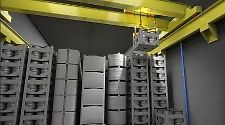
In a study of the potential post-closure performance implications of non-encapsulated wastes in standard RWMD containers, Quintessa identified that non-encapsulation of wastes might reduce the barrier performance of cementitious backfill due to formation of voids and collapse structures in the backfill. Working as part of the ASSIST consortium, Quintessa led a follow-on project to quantify the amount the amount of voidage in an ILW/LLW Geological Disposal Facility (GDF), and how this is affected by non‑encapsulation of wastes.
The project went on to consider how voidage in a GDF might evolve, and the implications for post-closure performance. Bounding scenarios of the evolution of voidage were developed in the context of the coupled Thermo-Hydro-Mechanical-Chemical (THMC) evolution of the GDF, in particular considering chemical and mechanical processes, and a range of different host rocks. The study concluded that non‑encapsulated wastes in Robust Shielded Containers (RSCs) may generally be acceptable in all host rocks, but non-encapsulated wastes in standard containers are only likely to be acceptable in limited numbers. The project report, 'An initial evaluation of the nature and amount of voidage associated with an ILW GDF' is available from the RWMD bibliography.
Image courtesy of NDA RWMD